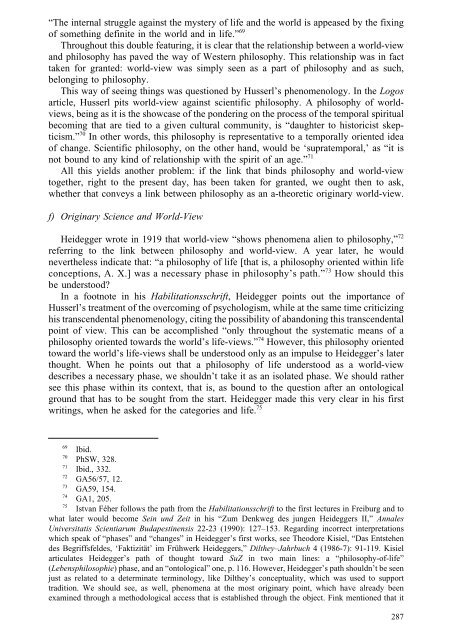[Andrzej_Wiercinski_(ed ... - WordPress.com
[Andrzej_Wiercinski_(ed ... - WordPress.com
[Andrzej_Wiercinski_(ed ... - WordPress.com
Create successful ePaper yourself
Turn your PDF publications into a flip-book with our unique Google optimized e-Paper software.
“The internal struggle against the mystery of life and the world is appeas<strong>ed</strong> by the fixingof something definite in the world and in life.” 69Throughout this double featuring, it is clear that the relationship between a world-viewand philosophy has pav<strong>ed</strong> the way of Western philosophy. This relationship was in facttaken for grant<strong>ed</strong>: world-view was simply seen as a part of philosophy and as such,belonging to philosophy.This way of seeing things was question<strong>ed</strong> by Husserl’s phenomenology. In the Logosarticle, Husserl pits world-view against scientific philosophy. A philosophy of worldviews,being as it is the showcase of the pondering on the process of the temporal spiritualbe<strong>com</strong>ing that are ti<strong>ed</strong> to a given cultural <strong>com</strong>munity, is “daughter to historicist skepticism.”70 In other words, this philosophy is representative to a temporally orient<strong>ed</strong> ideaof change. Scientific philosophy, on the other hand, would be ‘supratemporal,’ as “it isnot bound to any kind of relationship with the spirit of an age.” 71All this yields another problem: if the link that binds philosophy and world-viewtogether, right to the present day, has been taken for grant<strong>ed</strong>, we ought then to ask,whether that conveys a link between philosophy as an a-theoretic originary world-view.f) Originary Science and World-ViewHeidegger wrote in 1919 that world-view “shows phenomena alien to philosophy,” 72referring to the link between philosophy and world-view. A year later, he wouldnevertheless indicate that: “a philosophy of life [that is, a philosophy orient<strong>ed</strong> within lifeconceptions, A. X.] was a necessary phase in philosophy’s path.” 73 How should thisbe understood?In a footnote in his Habilitationsschrift, Heidegger points out the importance ofHusserl’s treatment of the over<strong>com</strong>ing of psychologism, while at the same time criticizinghis transcendental phenomenology, citing the possibility of abandoning this transcendentalpoint of view. This can be ac<strong>com</strong>plish<strong>ed</strong> “only throughout the systematic means of aphilosophy orient<strong>ed</strong> towards the world’s life-views.” 74 However, this philosophy orient<strong>ed</strong>toward the world’s life-views shall be understood only as an impulse to Heidegger’s laterthought. When he points out that a philosophy of life understood as a world-viewdescribes a necessary phase, we shouldn’t take it as an isolat<strong>ed</strong> phase. We should rathersee this phase within its context, that is, as bound to the question after an ontologicalground that has to be sought from the start. Heidegger made this very clear in his firstwritings, when he ask<strong>ed</strong> for the categories and life. 7569Ibid.70PhSW, 328.71Ibid., 332.72GA56/57, 12.73GA59, 154.74GA1, 205.75Istvan Féher follows the path from the Habilitationsschrift to the first lectures in Freiburg and towhat later would be<strong>com</strong>e Sein und Zeit in his “Zum Denkweg des jungen Heideggers II,” AnnalesUniversitatis Scientiarum Budapestinensis 22-23 (1990): 127–153. Regarding incorrect interpretationswhich speak of “phases” and “changes” in Heidegger’s first works, see Theodore Kisiel, “Das Entstehendes Begriffsfeldes, ‘Faktizität’ im Frühwerk Heideggers,” Dilthey–Jahrbuch 4 (1986-7): 91-119. Kisielarticulates Heidegger’s path of thought toward SuZ in two main lines: a “philosophy-of-life”(Lebensphilosophie) phase, and an “ontological” one, p. 116. However, Heidegger’s path shouldn’t be seenjust as relat<strong>ed</strong> to a determinate terminology, like Dilthey’s conceptuality, which was us<strong>ed</strong> to supporttradition. We should see, as well, phenomena at the most originary point, which have already beenexamin<strong>ed</strong> through a methodological access that is establish<strong>ed</strong> through the object. Fink mention<strong>ed</strong> that it287


